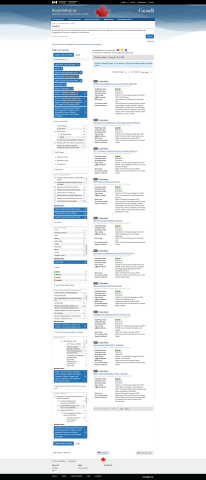Buyandsell.gc.ca was the Government of Canada's procurement portal up until around 2023 when it was replaced with CanadaBuys.
This project is what brought me to Canada's National Capital Region. As part of a team of contractors and members of the Public Service, my responsibilities on this project varied greatly including individual code contributions, requirements and scope gathering, UX design within the Government of Canada's standardized Web Experience Toolkit (WET), regular client collaboration, and leading an effort to redesign the search facets of the Procurement Data search tool.
The original procurement data search tool was a bit of a Frankenstein's monster. It consisted of a Drupal Search API View attached to Apache Solr that was frequently modified with custom code and functionality over the span of its almost decade-long existence. One of the many functionalities cobbled into this tool was the ability to subscribe to a certain search result. Once a user crafted a particular result using the search keywords and/or facets, they could provide the website with their email address and it would send a message whenever new procurement data was added to the site.
One of the problems with this approach was that options in Facets are only present if there is associated data within the current search criteria. Even with no search criteria specified, the site would not allow users to subscribe to tenders for Government Goods and Services Numbers (GSINs) or United Nations Standard Products and Services Codes (UNSPSCs) if there was no data in the system of any tender for those respective IDs.
Example: Let's say there has never been a tender for Key Lime Juice (UNSPSC: 50202405). As a result of this, even with a blank search query (i.e. browsing all tender notices) a facet for Key Lime Juice (50202405) would never appear as a selectable option. If a vendor of Key Lime Juice wanted to subscribe to tenders, they would not be able to build out the appropriate search query, and would not be able to subscribe to email alerts for this commodity.
In order to overcome this obstacle, part of the Search Facet Redesign project was to ensure that all options for large hierarchical datasets could be fully visible and selectable to the end user. This involved designing and building new, fully accessible UIs within the visual design language of WET.
I carefully collaborated with the client and the digital accessibility advisor to create intuitive enhancements to the UI of the facets. Enhancements included:
- Displaying all options regardless of data availability within the respective search query―effectively converting some of the facets into filters.
- Modifying the facets to clearly show all selected filters, ensuring accessibility.
- Enabling custom date range values through improved date selectors.
- Creating a new Hierarchical Selection List widget complete with keyboard navigation, screen reader compatibility, and lazy loading for extremely large datasets.
- Adding an in-widget search tool to allow users to search and rapidly select specific options in large datasets such as the UNSPSCs.
- Introducing a dialogue box to let users browse large datasets of options such as the GSINs and UNSPSCs, ensuring accessibility for those with cognitive disabilities.
With these enhancements, while it was possible for an end user to get a "no results" page, it still enabled them to subscribe to these results pages in the off chance that the Government of Canada would require a given product or service in the future.
